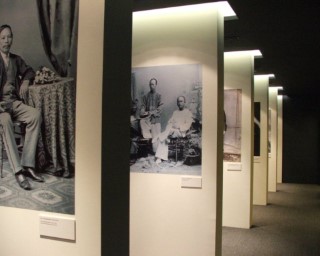Chinese More Or Less Exhibition

Chinese More Or Less: An Exhibition on Overseas Chinese Identity
何谓华人图片展
Occupying some 6,000 square feet, the exhibition titled, Chinese More Or Less: An Exhibition on Overseas Chinese Identity, is a central attraction in the Chinese Heritage Centre’s galleries. Conceptualised by the Centre’s former director, Ms Lynn Pan who is herself the author of the book “Sons of the Yellow Emperor” and editor of “The Encyclopedia of the Chinese Overseas”, the theme of “Chineseness” and Chinese Identity is explored and translated into visually interesting exhibits. Through the exhibition, visitors are probed into thinking such notions as
How Chinese am I?
In what sense am I Chinese?
What does it mean to be Chinese?
Three interesting sections make up this exhibition – Self, Other Self and Other Than Chinese
Self
This section showcases portraits of Chinese men and women from different eras, in different places and attires. These visuals are prone to prompt visitors into thinking about what makes these different looking Chinese “Chinese”? The
portrait is a means of self-representation. That representation is formed and transformed in the perception of others. And while I see myself as one kind of Chinese, others may see me as another kind.
Other Chinese
When Chinese leave their homeland (China), they bring with them memories, traditions and cultures from home. The “Chineseness” of such traditions and cultures are depicted through plentiful visuals and artefacts. The
visitor will come away from this section with the impression that there was a time in the diaspora’s history when the familial, cultural and political points of identification were entirely Chinese.
Other Than Chinese
On entering this third section, the visitor will discover that the world is more plural, that it changes faster and that there are now a variety of reference points that are other than Chinese. In terms of historical backdrop,
this section begins with the age of European imperialist dominion. The exhibition looks at the composite identities of the Baba or Straits Chinese (Malay and Singapore), the Peranakan Chinese (Netherlands Indies) and the Chinese Mestizo (Spanish Philippines)
showing the mingling of Chinese, local and European cultural influences in these identities.
From colonial West to the metropolitan west, the exhibition also explores the identity of a type of migrant not found in Southeast Asia – the student-turned-settler coming in search of better educational opportunities. Such a person looks upon his country of choice not as a place of settlement so much as an intellectual or artistic Mecca. Similarly, the work of Paris-based painter Zao Wou-ki who wrote his first name in Chinese characters and his last in Western orthography is also showcased. What this symbolizes is a double heritage – Chinese and other-than-Chinese. How an overseas artist relates to that heritage in his work is a theme explored in this section of the exhibition.
本展以“自我”、“其他华人”和“跨越华人"三个视角介绍世界不同地区、时代的华人,并为“华人”不同时代的定义进行探索与比照,籍此说明华人的身份认同日趋复杂,已不能被纯粹分类
从“自我”的观点出发,展览通过早期华人拍得照片,看到华人良好形象的自我表达。亦通过镜子的反射作用,借喻西方讽喻漫画和电影里,看到华人在外人眼中被扭曲、丑化的刻板印象
“其他华人”这一部分,引导观众探索华人与其他华人之间的比照,其身份认同的两大轴心“地方”与“国家”是如何随着时代而变迁的。
华人移民的历史漫长,跨越四海,接触许多中华民族以外的人而面临身份认同的多元选择。譬如殖民时期,华人与土著和欧洲人经长期的血缘和文化的融合,产生了多元文化与身份的综合群体,如马来亚的峇峇娘惹、荷属东印度(印尼)的土生华人及菲律宾的菲华混血儿。
如今现代化科技日新月异,文化因而跨越国界,身份认同日益多元,以致我们更难回答“何谓华人”这个问题。展览的最后一个部分“世界公民”,介绍了五名蜚声国际的华人及作品,以检视其中的文化多样性,包括中华文化的影响。这五名艺术巨匠分别是导演李安、画家赵无极和常玉、建筑师贝聿铭及大提琴家马友友。
